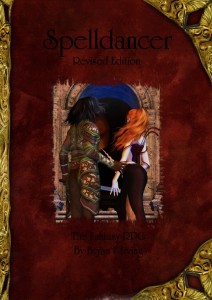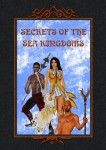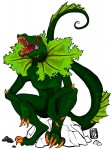Spelldancer
Spelldancer is a complete role-playing game published by Gethsemane Games.
By Brying F. Irving

Welcome to the twenty-eighth Designer’s Diary, a regular column where designers are given the opportunity to take readers on an in-depth ride through the design and development process of their system, setting, or product. If you’d like to share your product in the Designer’s Diary column, send a message to aaron@roleplayerschronicle.com.
Designer’s Description
Spelldancer is a flexible fantasy RPG set in a world of contrasts, where beast-men, including the “Ape-Sons” as humans are known, have come to dominate the nations of the world, but where far older things still lurk in the hostile environments where man and his relatives have yet to penetrate.
Amongst the now familiar fantasy races you will also find new creatures and ideas in a vibrant fantasy world that should be at once familiar enough to let you ease gently into the setting, and alien enough to feel unique and to let your imagination run wild.
Some of the fantasy staples are given a fresh treatment to various degrees, some more so than others, and under the surface there is always something new waiting to be discovered.
Purpose
Well, I had this game in my head, and if I didn’t write it, who else would?
Influences
The influences I drew upon for Spelldancer were wide and varied and range beyond the RPG field. Two strong influences in the development of the system were Chaosium’s RuneQuest, the second RPG I ever bought and to this day one of my favourites, and Pacesetter’s Chill. Chill was the first RPG I had seen in which the degree of success was important and the mechanic was not just a simple pass/fail. That influenced my game design ever since, although I didn’t want to include the mechanism for every single dice roll, it struck me as a way to make magic, combat and one or two other things vastly more interesting and varied.

Games like Dragon Roar also had an influence, like RuneQuest it included some sentient races based on animals, and it got me thinking about a world in which great apes were not the only phylum to have evolved into a sentient and higher order species. What would happen, I wondered, if wild boars or horses, or Felines had evolved a species as intelligent as humans? It also seemed a bit more interesting than the limited array of player character races usually available to players. Again, RuneQuest also had an effect on my thinking here, it was the first game I had encountered where – with the GMs permission – you could play just about any of the intelligent species in the game and I knew then I wanted to do the same with Spelldancer.
Miniatures I owned which I’d picked up from independent or unusual manufacturers also influenced the development of Spelldancer, as I included creatures and races based on interesting miniatures I’d picked up at various shows and events.
I also drew on art I’d seen or stories I had loved as a child, as well as folklore that had captured my imagination (although much of that would see much greater use in a later Gethsemane Games product – Haunts and Horrors, which drew very heavily on the folklore of many nations). I was fascinated with some of the Celtic and Norse legends of Elves, Dwarves and Trolls, and how they differed from what had become the Fantasy tropes.
Research
I spent years on research for Spelldancer one way or another. I set out by researching myths and legends (some of which I wove into the game and much of it I didn’t). The largest amount of research time though was spent on developing the cultures. I wanted the world to feel alive, and to help the player’s suspension of disbelief. I even selected my degree based on what I thought would help me bring an imaginary world to life, and it did. As a social scientist I was able to build societies that felt as if they could work and which logically progressed from their history, philosophy and even their geography.

For some of the adventures and supplements, such as Secrets of the Sea Kingdoms we researched meteorology and sailing as well as ship and boat building techniques, even for some adventures such as The Secret of Serpent Tor we spent hours researching things like gold values and purities, methods of refining it and so on.
Now with all that research it could sound to some one that is unfamiliar with our products that playing Spelldancer could be a very dry and academic experience, but it isn’t and we were keen to make sure it wouldn’t be. The research isn’t something that generally leaps off the page and whacks you over the head, it helped us make a smooth, functional setting that doesn’t leave you thinking something is wrong, or that X and Y shouldn’t work or wouldn’t be like that. To borrow a term from the computer programming industry, it is kept at the “back end” so that the user interface is an enjoyable experience and the player doesn’t need to be troubled by it. I think this is an attitude that has become more prevalent in the industry over the last decade and is why you have so many games now that present a setting that is in itself a joy to read and doesn’t set your teeth on edge the way some of the early ones did
Art Direction
If there is one single thing that was the bane of my life from the beginning of this product it is art and artists. No disrespect to artists you understand, but we have had some shocking luck in our dealings with them.
We actually binned all of the art that was initially created for Spelldancer as we didn’t like any of it in the end. Now to be fair, that was my own work. I was a bit unsure of it, but it is always difficult to accurately critique your own art. So I went to a dear friend of mine, Graham James, whose advice I always value on any creative endeavor because he is some one that will honestly tell you what he thinks and not what he thinks you want to hear. What he told me was “It’s crap, you would be better off with no art than that”, I told you he didn’t beat about the bush right! So I ditched it and engaged another artist – who drew one picture and lost interest in RPG work, leaving to work in comics instead.
Undeterred, I tracked down a third artist, who seemed very enthusiastic and turned in work I loved. We agreed to a price and the last thing I ever heard from him was that he was going on holiday for a fortnight and would finish the rest of the art when he got back, he refused to take any of the payments for the work he had already done, saying if I paid him before he went on holiday he would only spend it whilst away, and would prefer it if I just paid him the entire balance when I was happy with all his work. I agreed, since it was entirely up to him, and ring fenced his money in an account for when he wanted it.
He never came back from that holiday.
No one seems to know what happened to him, his website is gone, he no longer answers emails, his phone number is no longer valid, the places he used to sell his work no longer receives work from him and have been unable to contact him either. Every year I run an internet search for him and never find anything. Since he was never paid for the work he did do, I never felt able to use it but oh man I wish you could see it! It is some of the best work I’ve ever seen, it is as if he took the pictures direct from my brain and reproduced them with a few improvements!

Anyway, then we met Lupie Stardust, then a budding art student and she (as was, but he now) drew us some of the beast-men we wanted. Going was very slow as Lupie was snowed under with work for her degree and could only do a few pictures for us. Still, what she did we loved. You can see Lupie’s art illustrating the beastmen section of the Spelldancer rules.
Much of the rest of the art we bought from artists on RPGNow which has an excellent section for publisher resources.
You always walk a fine line with art, too little and it fails to help set the atmosphere, too much and it can be a distraction. We tried to use the art sparingly but in ways that would help to set the flavour of the game. One of the biggest problems we hit was finding art to depict the various ethnic groups that inhabit Spelldancer. A lot of available art is quite ethnocentric, and Spelldancer isn’t.

We hope the art we used has struck the balance we were looking for, but I think only the consumer can be the judge of that.
Gaming Experience
We wanted Spelldancer to be flexible, so that each group can use it to provide the fantasy experience that most appealed to them. If you want to play it as dark and gritty, you can, if you want a lighter, more upbeat experience, well, it caters for that too.
Similarly, because of the way the character generation works you can run both high and low powered games, either from the outset or you can use the system to recreate a “common man working up to hero” type of game.
Character generation is points based, but the number of starting experience points you begin with is based on your characters age, so if you want to play heroic-level characters at the beginning you can do so by starting with older characters, although the older you are the more disadvantage points you have to spend – and they must be spent either by taking disadvantages or sacrificing experience points. Similarly if you want to tell a story about every day people who work up to becoming great heroes, start them younger.
Where you set your games will also effect how comfortably familiar or utterly alien the cultures are to you. If the players want a medieval European style campaign then the Twin Kingdoms or the Empire are the place for you, for a nomadic dark ages flavour set it on the great steppes, and for something a bit more unusual, check out the Sea Kingdoms with it’s strict matriarchal theocracy and it’s clan and secret society system.
We have run all sorts of fantasy games with it, from murder mystery and skill based exploration sessions to high action adventure. Combat tends to be fast paced but excitingly varied as characters can select special moves and tactics to best suit situations without it slowing play down.
Skill use is also fairly immersive and we took pains to keep it from braking the flow of the game. GMs can set a difficulty level for a task and rule that anyone with the skill higher than that level succeeds without needing to test their skill, or they can have the players roll for success. We advise in the text a mixture of the two – when conditions are perfect let anyone with the skill over a certain level succeed, when they are performed under pressure ask them for a roll to see if they succeed or if the pressure throws them off their game.
Customizing is a theme that runs through the game as well. We wanted it too extend beyond character generation into play. So, mages can customize their spells as well as their familiars, magic items can be customized and so on. We want people to be able to play the game their way and to introduce elements that will give them the maximum enjoyment, after all, that is why we all play games, to have fun.
The setting also encourages players who wish to do so to become involved in the politics of Elizium, and we hope the world should feel alive to people. Without using a meta-plot as such, the world is full of things going on that will either sit in the background or open adventuring possibilities, depending on what the players wish to get involved in. We have found the game works very well for sandbox campaigns, although more preplanned ones work just as well. Again, we want people to take it and do whatever makes them happy in their gaming experience.
Development Process
Spelldancer was a very long time in design and development one way or another. Initially it began as a world setting, Elizium, which I used to introduce a new player to RPGs. I’ve been building fantasy worlds since I was a child, when I designed one to use as a setting for the various short stories I was writing. From an early age I was interested in the social sciences and how cultures developed as a response to their environment and history. I suspect part of the interest came from having a mother who was an anthropologist and grandparents with a ferocious interest in history.
Anyway, I laid down the foundations for what would become Spelldancer when I was in sixth form college (so I would have been about 16 or 17 at the time). The setting was then being used for my Dungeons & Dragons campaign, but by then I was already using a lot of house rules.
Eventually we decided the system didn’t model what we wanted to do with the setting all that well and I had meddled with creating a rules system some years before but ditched it when I decided it had become too complex, or “Crunchy” as we often say in the hobby today.
I was determined to return to the drawing board and rebuild the system pretty much from the ground up. There were elements I wanted to keep, but an awful lot that I didn’t, and I wanted to make the system more simple and intuitive to play.
We were play testing it to destruction at the time, and before long had a regular group of half a dozen players that were meeting almost every night to play it and comment on what worked, what didn’t, what they liked and what they disliked. Many of the suggestions were taken on board one way or another, but not all. We dropped most of the tables and charts and wanted to come up with something that let us play whatever games we wanted with only minimal adaptations of the system. We were creating a game engine that would form the core of most of future products, including Spelldancer but also our horror RPG Haunts and Horrors and our other releases, Entropy Effect, The Void and so on, which we haven’t released yet but are in the works.
The whole project was put on the back burner for a few years whilst I went to university and ran my own business to pay the bills. As I mentioned earlier, I majored in social science, a choice I made in no small part because I wanted to be able to build better game worlds. It was a hard time, running a business and studying for a degree whilst battling dyslexia and depression and trying to scrape a few hours here and there to work on the RPG and setting.
Nonetheless, I returned to full-time work on the subject after graduation and began to trim the system again, pruning out the bit’s I felt added little and refining it as much as possible. We assembled several new play test groups and distributed a few better versions for strangers to run as they didn’t have the same attachment and we felt they would view it with fresh eyes.
During that time I was also able to sneak into a few games run by strangers, keeping my identity as the author under wraps so I could see what other people did with the system and what they thought of it. I was greatly encouraged by the love of the game I witnessed and it convinced me to press on and take the game to the public. Hence Gethsemane Games was born (and named after my cat, since so many people inquire about the name).




